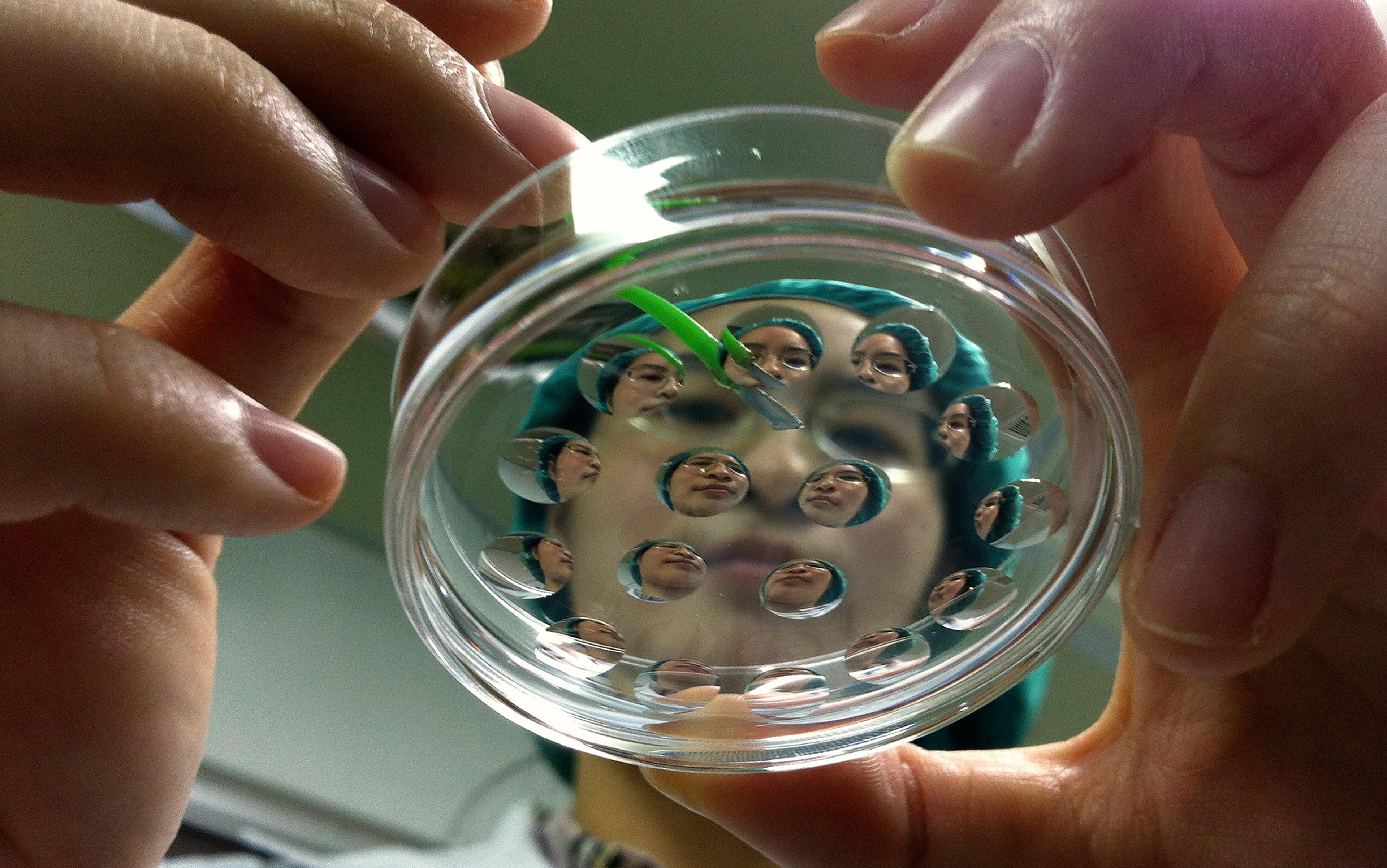The past decade has seen an avalanche of paradigm-shattering studies in the biological, toxicological and behavioural sciences: from findings published recently in Science and in Nature showing that sperm carry the marks of a man’s trauma and undernourishment, which leads to depression and metabolic glitches in his offspring, to the steady flow of research from the lab of the reproductive biologist Michael Skinner. Skinner’s research at Washington State University shows that in-utero exposure to environmental chemicals, such as those in plastics and pesticides, affects reproductive development, obesity and a wide range of diseases in adulthood. The weight of argument behind such findings suggests a radical conclusion: namely, that the environment not only influences the human body, it comes into it, shaping what it is – and who you are.
Such thinking cuts against the grain of what we’ve always thought about the human body: that its boundary is impermeable, its integrity complete, its unity sovereign. It suggests that we humans are nothing of the sort. We are porous, changeable, plastic.
[display_most_popular]
At the individual level, each of us is the unique expression of the total environment specific to our place and time: the products of our diet and nutritional status, and of the social and environmental conditions that influence it. We are shaped by, even made of the bacteria and viruses we encounter in our everyday lives, as well as a whole range of chemicals we’re exposed to through food, air, water and soil, at work, home, and in our consumer goods. We embody the stressful or stress-relieving aspects of our work and family life, socioeconomic status, racial privilege, trauma and war, and our experience of the built environment (from the stress of traffic jams to the calm of walking on the beach at sunset). And we are not only the expression of all these things in the current moment, but perhaps even more, in our past: the combined environment of our parents and grandparents is our molecular inheritance.
How might this novel understanding of biological development affect our understanding of human variation and difference? Or how we understand responsibility for biological outcomes, for example in health and disease? Evidence that we are, each of us, the crystallisation of a unique set of environmental influences suggests that responsibility for health is something dispersed across time and space, and that variation is the only possible outcome of development. Or does it? Do we see responsibility for health and disease as something collective; or do we reinforce the present obsession with individual behaviour? Do we embrace difference, or use knowledge of environmental influence to strive to achieve the ‘perfect’ human – blaming individuals when they fail to hit the mark?
For more than 35 years, Retha Newbold, an emeritus research scientist at the US National Institute of Environmental Health Sciences, has been running experiments with laboratory mice on the developmental effects of diethylstilbestrol (DES), a synthetic oestrogen. DES was widely prescribed to pregnant women in the US during the 1950s and ’60s to prevent miscarriage and promote lactation. A generation later, the children of these women suffered unusual rates of infertility and reproductive cancers, conditions that generally did not manifest until puberty and adulthood. While running her experiments, Newbold began to notice that many of her mice were getting fatter, so much so that she had to get larger cages to accommodate them. Eventually, she realised that having fatter mice was not coincidental, but a direct consequence of DES exposure in utero.
In the early 2000s, Newbold began to run experiments testing specifically for increased fatness from a variety of oestrogens. What she found was, she told us, ‘consistent, convincing and conclusive’: in adulthood, mice that had been exposed to these oestrogens perinatally (or immediately before and after birth) were much bigger than control mice, despite being fed the exact same diet and given the same amount of exercise.
While framing these discoveries as ‘endocrine disruption’, Newbold had stumbled upon what is now known as an epigenetic effect.
Epigenetics is a burgeoning field of research that is the most synthetic of the sciences in introducing the new, environmental view of biological development: it is the science of how cellular environments determine genetic expression. The field has yielded thousands of studies that show how certain nutrients, environmental toxins and psycho-social stressors can affect genetic expression without changing the underlying DNA sequence. Instead, epigenetic mechanisms affect genetic expression by influencing how DNA is packaged in the cell’s nucleus, and therefore which genes are available to the cell’s protein-building ‘machinery’. The most well-understood epigenetic process is methylation, in which a methyl molecule attaches to a gene, and then ‘silences’ it, making it unavailable for expression.
Our awareness of epigenetics challenges genetic determinism and throws a new wrench into nature-nurture debates
The effects of epigenetic mechanisms can be profound. For example methylation is now implicated in the severe birth deformities associated with Minamata disease (named for the town in Japan where it was identified), which results from exposure to methylmercury. Yet, in many cases the profound effects are not as immediately evident. Instead research shows there often is a time-lag: epigenetic marks laid down in utero influence health or disease in adulthood, and adult environmental exposures often manifest not in the individuals but in their children.
Epigenetic marks can be passed not only from a pregnant woman to her developing foetus, but perhaps across several generations. Bas Heijmans, a molecular epidemiologist at Leiden University in The Netherlands, has looked at methylation patterns of descendants of the Dutch ‘hungry winter’ of 1944-45, and found changes to a growth factor gene that have persisted over six or seven decades. Methylation of this gene has made the descendants much more prone to metabolic conditions than members of the general population.
Our new awareness of epigenetics challenges genetic determinism and throws a new wrench into nature-nurture debates. Epigenetic studies show that genes alone do not determine form and function, but that the cellular environment matters in making people who they are as biological and social beings. However, since the cellular environment itself is subject to a range of influences from inside and outside the body, epigenetics suggests that bodies are truly malleable in relation to their surroundings.
That said, it is very difficult to isolate an effect of a particular exposure, or to predict what the outcome of an exposure will be. Often the effects themselves are quite subtle. This is partly because in everyday life humans are exposed to an enormous array of chemicals with methylating potential – from stress hormones produced by the body to myriad exogenous chemicals – such as nutrients and environmental toxins – which reach us via food, as well as food containers, furniture, cosmetics, air and so on. These chemicals all interact, so that epigenetic processes appear to operate randomly.
In addition, the timing and dose of exposures also matters in terms of what response, if any, an environmental toxin might engender. For instance, studies on endocrine-disrupting chemicals are finding that exposures and effects do not rise together. Minute exposures at one critical moment of development can be more significant than large ones at another moment (so much for the dogma that ‘the dose makes the poison’). And because some epigenetic processes are initiated within the body – especially those stemming from psycho-social stresses – epigenetics casts the body as a participant in its own remaking. It is plastic, but not in any pre-determined or controllable way.
While this research is new – and many of the substances with known epigenetic effects are relatively new, too – there is nothing to suggest that epigenetic process are themselves new. On the contrary, it looks as if bodies and their environments have evolved in relation to each other since the beginning of biological time. As such, epigenetic researchers are effectively proposing a complementary theory of evolution to that of genetic mutation, based not only on Darwinism but on a radical form of Lamarckism. Jean-Baptiste Lamarck was the French evolutionary scientist who in the 1800s developed the theory of the inheritance of acquired characteristics, which was thoroughly discredited by Mendelian genetics in the 1860s for presuming that bodies adapt passively to their environment. Yet, in championing the environment as an active agent in human development that effects changes within a lifetime, a number of scientists, such as Moshe Szyf at McGill University and Eva Jablonka at Tel Aviv University, now equate epigenetics with neo-Lamarckism.
The implications of recent epigenetic insights are enormous. Epigenetics provides a powerful way to think about openness, indeterminacy and variation in human anatomy, physiology and behaviour. Foremost, epigenetics shows that variation is the inevitable, natural state: that is, variation is the only possible outcome because each person is made by a unique set of exposures, past and present. Its inevitability is enhanced by the fact that epigenetic processes are subtle and indeterminate. The upshot is that there is no ‘baseline’ for determining the ‘natural’ state of the human body.
In other words, there is no a priori basis to treat bodily changes as deviations from a past natural state. For example, the recent increase in human body size, overwhelmingly seen as inherently bad, might instead be a protective adaptation to the environment: bigger might be better. Differences among humans in characteristics such as size, mental acuity or gender identity are normal – not things to be controlled, or treated as disruption, or explained with reference to faulty genes.
Because epigenetic processes demonstrate that the body’s boundaries are porous and permeable, they raise fundamental questions about an individual’s ability to control his or her own body. This flies in the face of the overwhelming emphasis on individual responsibility that defines current approaches to health. Because many of the environmental factors with epigenetic effects also disproportionately affect disadvantaged people, epigenetics offers social, political and economic explanations for disease and disorders that heretofore have been attributed to bad choices or bad genes. Instead, such problems might be the biological imprint of unjust histories that cannot be rectified with better choices.
These conclusions are largely lost amid media scare-mongering. In January 2010, Time Magazine ran a feature on epigenetics emphasising how your environment and lifestyle choices could influence your genes. Titled ‘Why Your DNA Isn’t Your Destiny’, it discussed the ‘bad news’ that your decisions about smoking and eating could affect your children’s epigenetic inheritance. Or consider the website PreventDisease.com, reporting on the ill effects of Bisphenol A (BPA), a chemical common in plastics. The website lists six things you can do to avoid contact with it, from buying wholefoods to refusing to take the BPA-coated receipt when buying groceries. But if cash register receipts are routinely produced with BPA, how does refusing the receipt affect the plight of the cashier who handles them all day?
By sensationalising epigenetic research, popular media plays into existing fears about abnormality and personal responsibility. It suggests that bodies have veered from an evolutionary path and that these differences should be eradicated in the pursuit of health. Media reports enjoin people to take yet more responsibility for managing their health and capabilities by changing their lifestyle.
‘this study shows that my body has been invaded by toxins from all angles despite my efforts to the contrary’
When it comes to reproduction, media moralising is still more stark. CNN’s October 2013 report on studies linking phthalates (esters added to plastics to increase flexibility in, say, water bottles and food containers) with infertility and with oddities in men’s sexual development. The lesson? Couples seeking to get pregnant should limit the male’s exposures to phthalates. Since so many epigenetic processes are linked to pregnancy, it is most often mothers and future mothers who are called upon to be vigilant and self-controlled – sometimes by the scientists themselves. In May last year, Claudia Miller, professor of environmental and occupational medicine at the University of Texas, wrote in the Huffington Post advising women to adopt a ‘personal precautionary principle’ whereby they avoid all potentially problematic exposures in order to protect future generations.
In 2013, CBS News reported that the American Society for Reproductive Medicine and the American College of Obstetricians and Gynaecologists had teamed up, following a study linking BPA and miscarriage, to ‘publish a joint statement calling on doctors to raise awareness among pregnant women about environmental toxins and how to avoid them’. And in November 2014, Toronto’s Globe and Mail reported on a study linking maternal body mass epigenetically to children’s body mass, where the university’s publicists emphasised that mothers are to ‘blame’ for childhood obesity. At least bad moms are. Good moms, meanwhile, are ‘the cure’, by recognising that they can control their children’s fate.
Critically, women themselves often accept the idea that they should be and are in control of environmental exposures, and so make a host of lifestyle changes – only to be surprised and horrified to discover that, despite their actions, their body’s chemicals burden is still high. Reading their affronted testimonials offers a different take on who exactly ought to sit up and pay attention to epigenetic research.
In the report ‘Earliest Exposures’ (2009) from the NGO Washington Toxics Coalition, Connie Galambos Malloy, a new mother from California, describes her disappointment when body-burden testing revealed that she still had 13 of the 23 chemicals tested for, even after she’d made lifestyle changes during pregnancy to reduce her exposure to chemicals. She said: ‘I consider myself very well informed on environmental issues and more conscious than most of what toxins I expose myself to on a regular basis; however, this study shows that my body has been invaded by toxins from all angles despite my efforts to the contrary.’ The message from the women in this report is quite different from that in mainstream media: we ought to shift attention from the individual to public action to regulate chemicals whose effects are clearly harmful.
In highlighting the lifestyle directives that are emerging from this field, our intention is not to condone smoking or high-sugar diets, or to censure attempts to avoid environmental toxins. It is to suggest that epigenetic knowledge seems to be intensifying middle-class desire for improvement and control – and multiplying fears of difference and defect. For instance, a 2011 study by Brenda Eskenazi and colleagues at the Center for Environmental Research and Children’s Health at the University of California, Berkeley, linked the use of the common pesticide chlorpyrifos to falling IQs, an increased risk of attention-deficit and hyperactivity disorder (ADHD) and other developmental disorders, provoking anxieties about the social and economic implications of the loss of a few IQ points.
The Nation magazine reported on the subject last year, quoting Leonardo Trasande, a paediatrician and environmental health specialist at the New York University School of Medicine, who stated: ‘If one child loses seven IQ points, the teacher may not notice, the parent may not notice. But if 100,000 kids have a loss of seven points, the economy notices.’
Our own analysis of epigenetic science shows that most of the research in epigenetics has focused on high-profile conditions around which there is much social anxiety: cancer, but also obesity, neuro-developmental issues such as IQ, ADHD and autism, and issues in reproduction and sexuality, such as infertility, intersexuality and gender identity. Of course, there are good scientific reasons for these foci: the neurological, endocrine and reproductive systems together play important signalling roles and are central to physiological development. However, these are the systems that are most implicated in difference when writ as abnormality. Epigenetic research has drawn so much interest precisely because it ‘explains’ a trio of things that people already fear and detest: non-normativity in size, neurological difference and non-conforming sexuality.
Indeed, most of the illnesses and conditions that are the focus of epigenetic research, except for cancer, are contested conditions. One reason they are contested is that many of them have come into being through measurements and statistics that effectively define illness as a deviation from a norm rather than as an underlying pathology. Just as type II diabetes is now defined by elevated blood-glucose levels (rather than a set of symptoms), the Body Mass Index (BMI) clinically diagnoses obesity as a larger than average (or what used to be average) weight-to-height ratio. It does not actually measure adiposity; in fact, a high BMI can be the result of large amounts of bone or muscle as easily as fat. Meanwhile, IQ has long been under attack as a culturally biased and non-objective way to measure intelligence.
epigenetic science is communicated with promises of improvement, correction, even perfection: how to have the perfect baby
Another reason these conditions are contested is because they heighten stigma, whereas they could simply be seen as normal human variation. Thus fat-acceptance activists reject the medicalisation of obesity, and challenge the idea that fatness is a threat to life, as with the Health at Every Size movement. Some people diagnosed with ADHD argue that the condition has been identified to justify the pharmaceuticals developed to control it, while the neurodiversity movement seeks to redefine autism as part of the spectrum of normal human variation. The rising tide of transgender and intersex activism rejects the normalisation of two sexes/genders in a world of wide variation in sexuality and gender identity.
In both the scientific research and the popular media, epigenetics has not learned its own lessons regarding the lack of natural baselines and the inevitability of variation. When variation is seen to be linked to an epigenetic cause, that variation is treated as disease – and even more, as something to be cured. Notably, epigenetic science is being communicated with promises of improvement, correction or even perfection: how to have the perfect baby. Some studies have found that epigenetic effects are sometimes reversible, and many studies discuss the potential of improvement through biomedical intervention. The aforementioned Time Magazine article claimed that the ‘good news’ to counter the ‘bad news’ about epigenetics is that medicines are being developed to treat illnesses by ‘silencing bad genes and jump-starting good ones’. In his book Epigenetics: How Environment Shapes Our Genes (2012), the science writer Richard C Francis likewise says that epigenetics brings ‘good news: unlike mutations, epigenetic effects are reversible. Indeed, epigenetic engineering is the future of medicine.’
But here’s the rub. At the same time that epigenetics opens us to new ways of thinking about body-environment interactions, we are presented with a very narrow view of what we ought to be and what we ought to do about who we are. To us, epigenetics suggests that because the human body is permeable and plastic, and because human development is not as controllable by our wills as lifestyle gurus lead us to believe, we would do well to learn to live with difference and indeterminacy.
Yet reports on epigenetic research suggest the opposite: at the least, they argue, we ought to be more alike and ever more vigilant about our lifestyles to maintain that normality. More: we ought to strive to be even better – with biomedicine promising to eradicate some of the differences that frighten us. At its worst, epigenetics offers us a biomedical future in which the perfect human is engineered: thin, smart, outgoing, heterosexual, gender-conforming, lacking physical disabilities, able to sit still and work hard, and (given widespread preference for light skin) white. The spectre of The Stepford Wives rises for us all.






